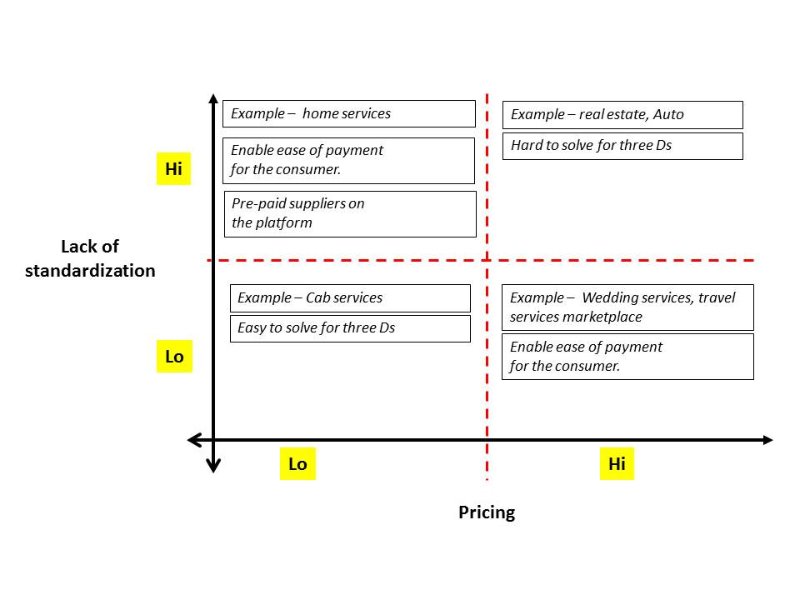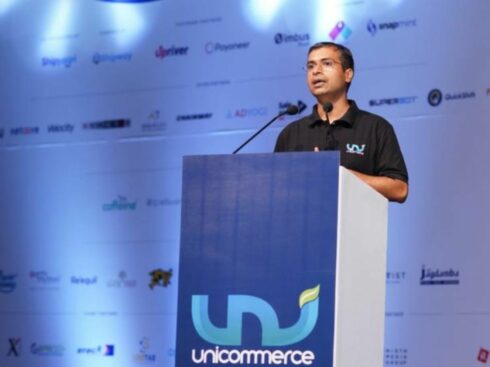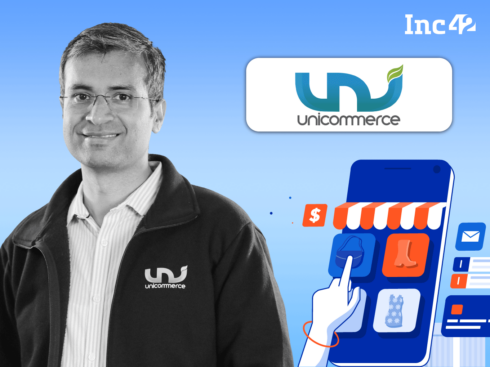Part I: Winning the Online Marketplace – Part I ‘Importance of the Supply Side’
As you think about developing the core value proposition for the consumer (‘demand’ side) of your marketplace business (be it product or services), there are three essential aspects that the platform needs to solve for – (1) Discovery (2) Decision making (3) Delivery aka the three ‘Ds’. Before we get into the specifics of how to solve for each of them, it’s important that to define these aspects and more importantly, understand their significance –
Discovery
This aspect involves providing the consumer with the satisfaction that she is scanning the entire gamut of options available – Read ‘She believes that the probability of finding what she is looking for is the highest in the shortest period of time and there is enough variety to choose from’
Decision Making
This aspect enables the customer to decide which service provider to use or which product to buy – how many times have we been in situations wherein there are five suppliers (or products) with different price points for the same service – in short, its painful!
Delivery
Is about the final ‘consumer experience’ (Read ‘this aspect will decide your customer lifetime value’). If this aspect of the platform experience doesn’t work, you are essentially leaving your consumer ‘high and dry’ – she has invested her time and energy in discovery, decision making and now to her bitter disappointment there is no one to complete the service or the experience is terrible (read ‘no service standardization’ or ‘supplier incentive’). A poor experience will overshadow all the other good work and you can trust the consumer to never come back and also, share her ‘heartburn’ with others.
With definitions out of the way, let’s talk a bit about the significance of these aspects – How the platform handles (or mishandles) these aspects has a direct consequence on the consumer experience. Another way to look at it this is to understand that each of the above aspects of is a point of ‘friction’ for the consumer. Each point of ‘friction’ expects the consumer to do something that she essentially might not wish to do at all – for example apply her mind to something mundane, be physically present somewhere, spend time on not so interesting stuff etc. Not to forget that this consumer is ‘time impoverished’, they wish to get stuff done at a rapid pace without doing or thinking much at all – and this is essentially the problem (read ‘biggest opportunity’) which the platform needs to solve for and finally, get paid for.
If this wasn’t important enough, the ability of the platform to control the ‘Ds’ provides for a distinct business model advantage of what we call being ‘inline of payments’ – which in simpler terms mean that the platform controls the flow of money from the demand to the supply side. Well, so what? – As the platform controls money flow it moves away from a ‘listing’ to a ‘transaction’ marketplace business model (I flesh out some of the key advantages of this below). For example, all cab operators are present on multiple listing marketplaces like Just Dial, Sulekha etc. which in their current avatars only enable ‘discovery’, however, Ola (Full disclosure – Bessemer is an investor in Olacabs) controls all three Ds and hence is able to charge a commission. Similarly, travel experts pay a flat fee to the listing platforms while Travel Triangle (Full disclosure – Bessemer is an investor in Travel Triangle) controls the three Ds and hence, is able to charge a commission on the total transaction value.
There are multiple advantages of being ‘inline of payment’ – (1) Potential market expands as the platform charges a commission of the transaction value (8-10% of ~ $ 8 bn leisure holiday market) rather than a flat listing fee per provider (200,000 travel experts paying $ 1,000 per year which is $ 200 mn) (2) The platform acts as an escrow account and can control the transaction – it assumes the position of an arbitrator for any dispute and can control the demand and supply side experience closely (3) The platform keeps its share of the transaction value without any collection, or disinter-mediation issues and hence, can scale the business much faster (no resources required to ensure the platform gets it share after the transaction has closed; it’s is painful for a platform to pull cash from the supply side once they have received it in their pocket !) (4) Cash flow eases (read ‘negative working capital’) as the platform collects money and assuming it holds the same for a while before disbursing the share of the supply side.
Keeping the above advantages in mind, let’s look at what you as an entrepreneur can best do to cater to the three ‘Ds’ –
Discovery
While entrepreneurs do a great job in building depth and breadth on the supply side to maximize the probability of a transaction, the key question ‘how much choice to offer to the consumer?’ remains. Following is a broad framework for solving the issue –
- Any product or service which is ‘experiential’ in nature (travel planning) or has an impact on consumer’s ‘social status’ or is ‘personal’ (fashion apparel) or carries a big price tag (real estate, auto) – the consumer will appreciate a curated offering and will be willing to spend time & energy to scour thoroughly before taking a decision.
- Any product or service which is commodity – example cab services, home services etc. the consumer just wants the work done quickly without spending any time on choosing the service provider. Get the consumer someone skillful quickly!
Decision Making
Following are some of the ways I have observed platforms solve for the decision making aspect –
- Better matching of demand and supply through data– matching demand and supply through better understanding of the capability set of supply side and need / behavior of the demand side can be golden for the platform – this involves collecting and continuously updating supply and demand side data with an overlay of an algorithm that learns from the preferences on both sides. There are enough 3rd party tools to help you collect and analyze behavioral data on the demand side, while for the supply side, and this is where I re-emphasize on having a deep supply side product (more on this here http://wp.me/p6muDe-8) which can generate high quality data for you to understand capability, behavior and motivations in greater detail. Case in point is Travel Triangle (TT) which matches travelers demand (destination, budget, customization needs) with the right travel expert whose capability, performance and behaviour is continuously captured on the supply side product. The power of this matching service is amplified manifold when provided in context of user generated ‘real’ reviews.
- Real user generated reviews is one of the most powerful methods to enable decision making for the consumer. Having said that there are at least two other advantages (1) Adds to business defensibility – more reviews means better consumer experience and hence, more consumers; which in turn means more reviews and there is a potential network effect here (2) Disciplining the supply side – with a critical number of reviews in place, you can enforce the ‘carrot & stick’ strategy with the suppliers. Good reviews mean more business and bad ones push suppliers further down in the discovery list and finally will threaten the existence of the supplier on the platform.
Delivery
As mentioned above, delivery is key to delighting the consumer after she has spent valuable time and energy working through the discovery and decision making stage. In certain cases the delivery aspect is straightforward – get the product in time or deliver a standard service like a cab service. However, this is not true for all types of services. For example, how does a platform ensure that a plumber or an electrician doesn’t overcharge for the scope of work? How does the platform ensure consistent service levels? (These lingering questions make the consumer experience uncertain and unpleasant) – these are often the kind of services wherein the scope of work cannot be defined before the service provider investigates the situation at hand. In such cases, wherein the platform is not naturally ‘inline of payments’ I have observed founders employ a combination of the following tactics –
- Ease payment hassles for the demand side& make the platform prepaid for the supply side – Offer the consumer to pay through a wallet / online payment which eases payment hassles for the consumer while enables the platform to record value of the transaction and hence, be inline of payments. While on the supply side, create a prepaid telecom offering wherein they receive leads only if they maintain a minimum balance with the platform – this amount keeps reducing as they service leads.
- Platform creates a window for negotiation before the service provider turns up, so the negotiation goes into ‘decision making’ aspect and not during ‘delivery’ wherein the consumer is expecting things to work seamlessly
- Standardize / productize services to create a set menu for work and pricing (hard to do!)
Some marketplaces are naturally geared towards for providing a high quality experience across the three ‘Ds’ while some other require careful handling of each of these aspects. The fact that you can easily control the three aspects is a function of two things – (1) Product complexity / Lack of service standardization (2) Pricing. Following are two examples –
Product complexity low / degree of service standardization high, Pricing low – example cab services, high degree of service standardization (order the car type, get in and get driven); Pricing is standard, easily comparable and small % of annual income; Outcome – easy to solve for the three ‘Ds’.
Product complexity high / low degree of service standardization, Pricing high – example real estate , multiple product types, multiple evaluation parameters, multiple stakeholders in making decision; Pricing fluctuates, hard to compare and changes often, significant % of annual income and hence, bad decision can be difficult to get out of. Outcome – very hard to solve for the three ‘Ds’ and hence, listing model exists.
In summary, keep the following ‘Three Ds Matrix’ in perspective when evaluating the ease of getting inline of payments –

[Disclaimer: The views expressed here are solely those of the author in his personal capacity and do not in anyway represent the views of the organization.]



























